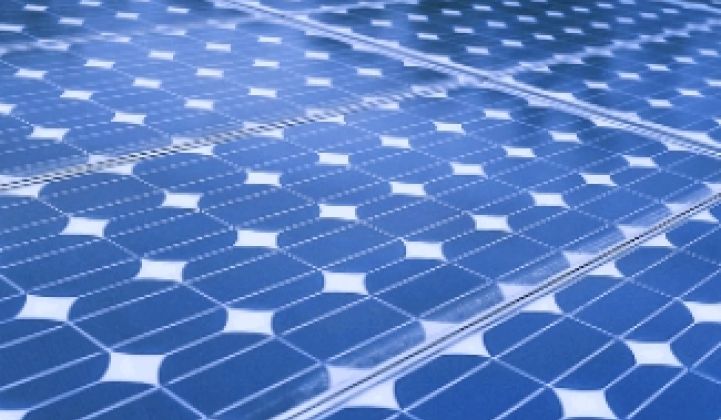TAIPEI, Taiwan -- If you can manufacture one thing successfully, you can make other stuff too.
That's the approach being taken by Powercom, an established maker of backup power equipment and software, and one that you will likely see more of as Taiwan expands into solar. Powercom has made computer components for years, but a few years ago started making inverters, which convert the direct current from a solar energy system into the alternating current for feeding the grid, and it lined up a solar power partner.
The company is now getting into polysilicon production as well.
It's an ambitious undertaking for Powercom, which hasn't been immune to the credit crunch that has plagued the rest of the industry. Still, the trend bears watching. Although the actual production of products has shifted to mainland China, Taiwanese companies remain some of the world's chief experts on logistics, cost control, product design and designing for mass manufacturing. Many factories in China, in fact, are owned by Taiwanese outfits. As solar expands, this sort of know-how will play a larger role.
"My boss really believes in vertical integration," said Amos Yu, marketing manager at Powercom on Tuesday.
Indeed, Powercom started in 1987 to make uninterrupted power supply equipment for computers, networking equipment and other devices. The company makes all of the components except the batteries for building the UPS equipment, Yu said.
It now has roughly 2,600 employees and churns out three million UPS units per year.
Taiwan is home to some of the world's largest semiconductor and gadget makers. Companies, such as Hon Hai Precision Industry (Foxconn), manufacture goods for brand names such as Hewlett-Packard, Apple, Cisco, Dell and Motorola.
In recent years, many of these established Taiwanese electronics companies and industry veterans have eyed the solar business as a logical and, of course, potentially lucrative one to enter. Making solar cells and assembling them into panels shares similar processes as making chips and flat display panels.
The same trend has taken root in Silicon Valley. Santa Clara, Calif.-based Applied Materials, which is the world's largest semiconductor factory equipment maker, marched into the solar energy industry in 2006 to make factory equipment for making cells and panels.
National Semiconductor, another decades-old company that is likewise headquartered in Santa Clara, used its know-how in designing power management chips to develop a device that the company said could boost the energy output of each solar panel.
Powercom, which is traded on the Taiwan Stock Exchange, dived headlong into the solar business by investing in Taiwan's Top Green Energy in 2005 and formed its own solar panel production factory in 2006. It also began developing an inverter around that time and announced in January last year that it could provide mono- or multicrystalline silicon solar cells, panels and inverters.
The company would sell its products under its own brands as well as make them to order for other companies.
The average efficiency is 17 percent for the monocrystalline cells and 16 percent for multicrystalline, Yu said.
Once it had entered the solar market, Powercom scanned the industry – and in particular the competitive landscape in Taiwan – and decided to get into the polysilicon production business as well. Solar cells make up 80 percent of the cost of making a solar panel, and silicon wafers make up 70 percent of the cell costs, Yu said.
When Top Green was considering the polysilicon market, there were already several silicon ingot and wafer makers in Taiwan, but no polysilicon producers, Yu said.
"We figure that polysilicon is the key to do anything," he added.
So last month, Top Green, in which Powercom is the main shareholder, broke ground on a polysilicon factory in central Taiwan.
The global financial crisis has slowed the development pace for Top Green, however. Raising money remains difficult and market demand has shrunk, causing many solar equipment companies worldwide, including polysilicon makers, to delay factory expansion plans or post losses (see LDK Solar Faces Tough Road Ahead, Says Analyst and Silicon Producer SilPro Teeters on Bankruptcy).
Top Green had planned to start building the polysilicon plant toward the end of 2008, Yu said. The company had also aimed to reach a production rate of 3,000 tons per year for its first phase. That has been scaled back to 1,500 tons per year, Yu said.
Building the first phase would cost about NT$7 billion ($212 million) and would come from bank loans and Top Green's existing investors, he added.
The company would initially use the polysilicon from the plant for its own solar cell production, but would sell it to outside buyers in the future. Top Green, which plans to outsource wafer production, has a 30-megawatt solar cell factory.
Powercom buys solar cells from Top Green and Solartech, another Taiwanese company, for producing panels at its 45-megawatt factory, Yu said. Solartech is also a Top Green investor.
Both Powercom and Top Green are devoting their resources to getting the polysilicon plant up and running, and currently have no plans to expand their cell and panel production, he said.
The companies would remain small players and, at least, increase their production capacities to compete with the myriad of larger players in Asia, Europe and the United States. Offering inverters along with solar cells and panels (or perhaps polysilicon in the future) is not a guaranteed winning formula.
Yu was reluctant to name the customers that were buying panels and inverters from Powercom. He said the company is working mostly with distributors in Europe and residential real estate developers in the U.S. He did say that Yuraku, in Spain, is one of its customers.
Join experts and influencers at Greentech Media's Growth Opportunities in the New PV Market: Projects, Finance and Policy in San Francisco on July 13.




